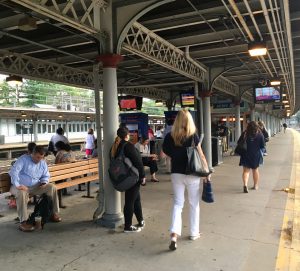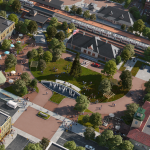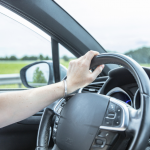New Jersey Future Blog
Transit-Oriented Development is Pedestrian-Oriented Development
January 30th, 2023 by Tim Evans

Trenton Transit Center, Trenton NJ. Photo Credit: New Jersey Future
Despite being the most densely populated state in the country with over 150 train station towns, New Jersey is not a safe place for pedestrians of any age. In our effort to reduce car dependency, increase pedestrian safety, and encourage placemaking that serves the public, NJ ended 2022 with several announcements designating funds for advancing pedestrian and bicycle safety and transit-oriented development (TOD), indicating that the administration recognizes the importance of creating and fostering transportation options besides driving. Here’s a few recent developments of note:
- NJ Transit receives federal grant funding to study light rail in Hudson and Bergen Counties. [NJ.com]
- New engineering contract indicates major step forward for light rail line connecting Camden and Glassboro. [NJ.com]
- Murphy Administration disperses money across 56 municipalities to implement street safety and connectivity projects. [ROI-NJ]
The common goal among these projects is compact, walkable urbanism. Transit-oriented development must be pedestrian-oriented development, since transit riders become pedestrians the moment they step off the bus or train. Before private automobiles became the default method of transportation, most towns, including most of New Jersey’s urban centers and first-generation “streetcar” suburbs, were designed with walking in mind. The whole point of transit-oriented development was to enable transit riders to safely access the station on foot, and to access other commercial destinations along the way. These same clusters of destinations also made trips shorter and more efficient, often without needing a car, for other local residents who were not transit commuters.
These older centers present a massive opportunity for NJ to reduce car dependency. Centers with multiple destinations (sometimes including a transit station, sometimes not) located within easy walking distance fell out of favor in the second half of the 20th century, as automobile ownership became nearly universal and development patterns changed to focus on accommodating cars rather than people. But the legacy of walkable urbanism is still visible in New Jersey’s relatively low rate of vehicle ownership, compared to other states that experienced most of their development after the car became dominant. In NJ, 11.2% of all households1 do not own a vehicle, the third-highest rate in the country after New York and Massachusetts. (This translates to about a million people who are reliant on some other mode of transportation besides a car for their daily needs.) And another 34.8% of households have only one vehicle available, bringing the share of NJ households that are able to live either car-free or “car-light” (only one vehicle) to 46%, or almost half.
The good news is that towns that embody the live-work-play-shop environment are becoming popular again, giving states like New Jersey with many older centers a competitive advantage. The 153 municipalities in New Jersey that host a transit station (rail, ferry, or major bus terminal) accounted for 68.6% – more than two-thirds – of total statewide population growth between 2010 and 2020, up substantially from only 27.8% of total growth in the 2000s and 35.8% in the 1990s. More precisely, the 124 municipalities that best embody the concept of walkable urbanism (with or without transit stations) and score high on all three New Jersey Future smart growth metrics—high activity densities (people + jobs per square mile), mixed-use downtowns, and well-connected, walkable street grids—together accounted for more than half (57.5%) of the statewide population increase in the 2010s, compared to only 13.6% of total growth in the 2000s.
Compact, walkable, mixed-use centers produce a host of societal benefits. For one thing, given the transportation sector’s outsized role in the state’s overall carbon footprint, enabling people to take at least some of their trips on public transit, or by non-motorized means —and shortening travel distances for those trips that are still taken by car—is an effective strategy to reduce the state’s greenhouse gas emissions without waiting for electric vehicles. Reducing the need to drive by making non-driving options more accessible and comfortable would also address other problems that electrifying the vehicle fleet will do nothing to resolve, such as reducing traffic congestion, improving pedestrian and bicyclist safety, reducing the expenses involved in owning a vehicle (especially important for lower-income households), allowing people to spend less time in the car commuting and running errands, improving public health as a result of more people using more active modes of transportation, and reducing per-capita infrastructure needs and the public expenditures they engender.
To encourage less car dependency, alternatives must be safer, more enjoyable, and available to more people. To this end, transportation planners at the New Jersey Department of Transportation, New Jersey Transit, and at the county and municipal level need to include the needs of non-drivers as an integral part of the planning process and not just as an afterthought. This includes incorporating pedestrian improvements into efforts to promote TOD. Because all users of the transportation system are pedestrians at some point.
__________________
12021 American Community Survey one-year estimates
Related Posts
Tags: car dependency, Pedestrian, pedestrian-oriented developemt, pedestrians, Smart Growth, Transit, Transit-oriented Development, Transportation, walkable, walkable urbanism
















